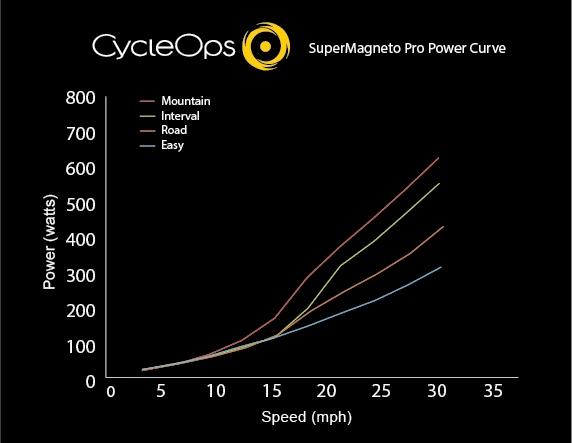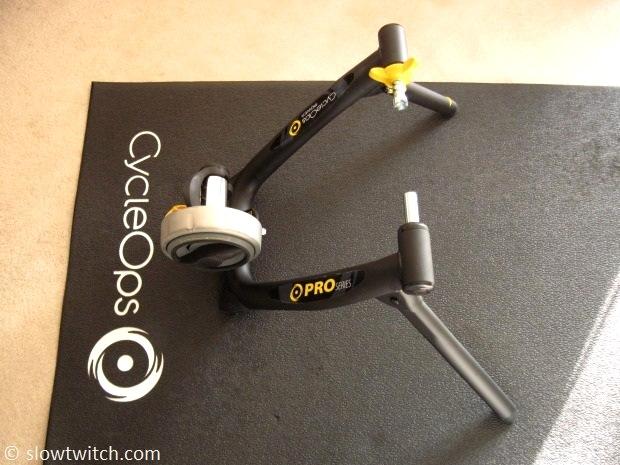Historically, I’m a big fan of trainers with fluid resistance units. They seem to be quiet, last a long time, and offer progressive resistance (e.g. the required effort gets higher as wheel speed increases). In fact, I still own and use a CycleOps Fluid2 that I bought over ten years ago. All I’ve had to do is replace the small L-bolt that adjusts the roller, along with the cam bolt that clamps the rear skewer (they eventually wore out after about eight years).
My experience with magnetic resistance trainers has been less favorable. They cost less, but I’ve never found one that was quite up to the level of my Fluid2. Nonadjustable mag trainers tend to be too weak for very hard workouts, and adjustable designs never seem to quite re-create the smooth fluid feel (at least the ones I’ve tried).
That all being said, CycleOps proposed a challenge: We bet our SuperMagneto Pro will change your opinion of what a magnetic trainer is and can be. They sent one over to me early this year, when I was actually looking for a trainer for an entirely different reason: I wanted something with a heavy flywheel for realistic road feel (more on that later).
It arrived at my door in that familiar black CycleOps box:

Let’s hit the basic specs.
CycleOps SuperMagneto Pro specifications:
MSRP: $419.99
Resistance unit: Progressive magnetic
Resistance levels: 4
Roller size: 2”
Tire diameter range: 650c road to 29x2.25” MTB
Rear hub spacing: 130 – 135mm
Warranty: Lifetime
The Super Magneto is in the Pro Series of trainers from CycleOps. One benefit of the Pro Series is that they arrive completely assembled. If you’re a buffoon with club hands like me, you might get a little frustrated with the generous cardboard packing… and tear through the box on ‘accident’. No picturesque unboxing process here at Slowtwitch…

The other items in the box are a steel rear skewer, training DVD, and an offer for a six week Matt Dixon coaching program.

Push the button to extend each leg:

One leg has a knob that you can turn to extend the rubber foot (for uneven floors):

Here is a look at the magnetic resistance unit.

CycleOps tells us that there are four rare earth magnets inside, which slide away from the center of the flywheel as you pedal faster and faster. In other words, that’s the magic sauce that makes the resistance go up like a fluid trainer.
In addition, there are four different levels of adjustment – Easy, Road, Interval, and Mountain (translates to ‘easy’, ‘medium’, ‘hard’, ‘super hard’):

It is important to note that each of these settings starts at the same point; the resistance always begins at zero. It's the pitch of the curve that changes:

My SuperMagneto Pro has a plastic lever that adjusts the roller. You lift it up to bring the roller to your tire. To make large adjustments (e.g. move the roller a farther distance to accommodate a different size wheel), you must turn the lever 90 degrees – and then move the resistance unit manually.

This is the only real part of the trainer that was a disappointment. It works, but it is finicky. I used the trainer with two wheel sizes; my 650c and 700c tri bikes. When switching between the two, I’d always have a little bit of trouble dialing it in. My old Fluid2 has a simple L-bolt to do the job; it’s a no-brainer, but can strip out over time.
The good news is that by the time you read this, the design has already changed. The latest system is called a ‘clutch knob’, which they say works similar to a ratcheting gas cap.
The locking mechanism that holds the rear skewer is very simple and effective:

The yellow portion rotates to extend the silver threaded piece. There are indents that you can feel as it tightens down. It’s almost impossible to over-tighten; the yellow paddles are relatively short to limit the leverage you have.
The Wheel in the Rear Keeps on Turnin’ (translation: Test Riding)
Now that we know all of the technical details, it’s time to ride.

Overall, I found the feel of the SuperMagneto Pro to be very smooth and ‘road-like’. It is very quiet for a trainer of this type, especially with the CycleOps trainer-specific tire ($35). I found myself using the ‘Road’ setting for easy-to-moderate rides, and the ‘Interval’ setting for moderate-to-hard rides. To me, the full ‘Easy’ setting was too easy, and I’m not manly enough for the ‘Mountain’ setting.
I never felt the need to change settings in the middle of a ride. The most enjoyable thing I found was that the resistance felt very progressive. Whereas my Fluid2 has a very steep curve for every ride, the SuperMagneto allows me to pick based on the type of ride I’m going to do. I actually bought a special 10-speed 12-23 cassette for my Fluid2 specifically because the curve is so steep (smaller jumps in gear ratio help to minimize the effect). With the SuperMagneto Pro, I end up using more gears in my cassette and both chainrings; it feels like riding outdoors.
As I mentioned in the introduction, I found this trainer because I was looking for a heavy flywheel that would maintain momentum. In that respect, this trainer is much better than I’ve ever experienced. If I had to take a stab, I’d say that the rear wheel will coast for about five times as long as my old trainer. I can hop off the bike, adjust my shoe, do two cartwheels, get back on the bike, and it is still spinning.
The reason I wanted a heavy flywheel was to isolate chain and crank speed by keeping wheel speed relatively constant. Some people suggest that light flywheels negate the effect of any non-round chainring (Rotor, Osymmetric), which intend to manipulate the speed of the crank throughout each revolution. We’re working on an evaluation of some of these crazy rings, and this trainer should do the job.

It is worth noting that while the bike is secure in the trainer, there is some measure of flex in the system. I don’t know if it is intentional or not, but the net effect is that the bike will sway slightly side-to-side as you pedal. The silver pieces that hold the skewer (above) will flex up and down somewhat. If may feel disconcerting if you’re used to a dead-solid trainer, but you could also argue that it feels more realistic. To me, it’s a shoulder-shrug issue.
How do you choose between this trainer and anything else? The first decision is price. This thing ain’t cheap, and that’s going to weed out some would-be customers. Beyond that, the main decision is whether you want a trainer that is driven by the tire (e.g. most traditional trainers) or by the chain (e.g. CycleOps Silencer, Wahoo KICKR, etc). The latter designs claim to be quieter, but I would not call the SuperMagneto loud.
The main factor, in my mind, is convenience. The wheel-removal trainers are more cumbersome. If you have enough space in your home to leave a bike set up permanently on the trainer, they’re great. If you have limited space and must set up your bike and trainer for every ride, they’re a pain. I’m in the second group, so I prefer the wheel-driven trainers.
--
UPDATE: CycleOps provided an image of their new-style Clutch Knob that adjusts the roller to meet your tire. As mentioned previously, it tightens to a certain point, and then 'clicks' like an automobile's gas cap.



